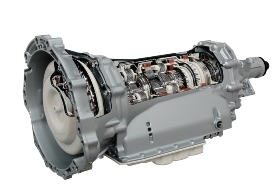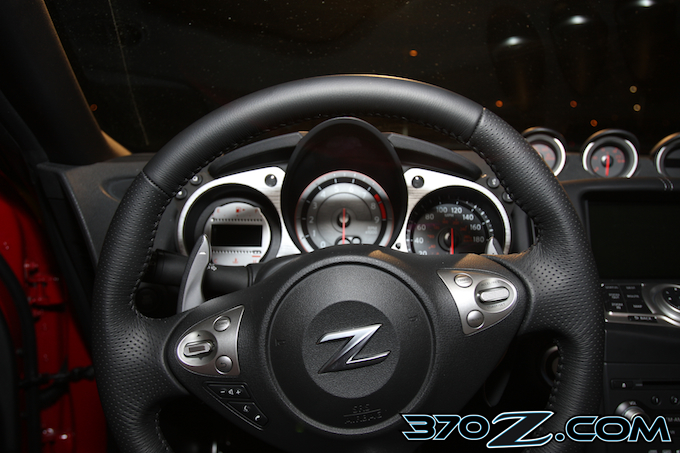Mike Kojima posted on January 01, 2009 02:50

The 370Z will also be available with Nissan’s new and innovative close-ratio, wide-range 7-speed automatic transmission. In addition to regular automatic shifting and manual shifting through the stick, the 370Z’s automatic also features steering wheel mounted, racing inspired paddle shifters. The automatic has been programmed to allow fast shifting during aggressive driving at 500 milliseconds a shift and automatically rev-matches when downshifting in manual mode. As a really cool innovation, the transmission also aggressively applies the lock up clutch in the torque converter in between shifts so the transmission does not slip and has a direct feel like a manual transmission. In automatic mode, the transmission features ASC or adaptive shift control where the transmission adjusts the shifting logic on the fly to match the driver’s driving style.
 |
| The 370Z’s automatic transmission features an amazing 7 speeds, fast shifting, rev matching on downshifts and torque converter lock up strategy to give it a manual transmission like response and feel. |
With seven forward ratios, the automatic transmission has the advantage of having closely spaced ratios to help keep the engine in its powerband. With a really low 4.924 first gear, and a deep 0.771 overdrive seventh gear, the automatic transmission can give both good acceleration and good fuel economy with the automatic having identical fuel mileage to the manual in mixed-cycle driving. The automatic transmission has a slight weight disadvantage to the manual being about 37 lbs heavier.
 |
| The 370Z’s automatic transmission has steering wheel mounted paddle shifters just like a race car. |
With the close-ratio spread, torque multiplication of the torque converter and the unique application of the lock up clutch in between shifts, the usual differences in performance between automatic and manual transmissions are narrowed. Perhaps the automatic may even best the manual? Again time will tell!
Below are listed the gear ratios and final drive ratios of the 370Z's manual transmission:
Gear Ratios (Automatic)
| 1st |
4.924
|
| 2nd |
3.194 |
| 3rd |
2.043 |
| 4th |
1.412 |
| 5th |
1.000 |
| 6th |
0.862 |
| 7th |
0.771 |
| Reverse |
3.972 |
| Final Drive |
3.357 |
From the transmission the power is transmitted to the rear differential through a light weight carbon fiber driveshaft to an optional viscous limited slip differential. A viscous limited slip differential differs from a standard limited slip by how the clutches are engaged. Nissan's viscous unit uses a thick sticky silicone fluid inside the differential housing between the clutch plates. When the wheels spin in opposite directions as when one wheel starts to spin in conditions of unequal traction, the clutches slip against each other. Initially the silicone fluids thixotropic properties resist the shearing action between the clutches. The shearing action also creates heat which makes the fluid expand driving the clutch plates harder against each other giving more locking action. Viscous limited slips are very smooth and quiet. They are almost transparent in operation to the driver.
The carbon driveshaft offers several advantages to the typical steel driveshaft. First, it is several pounds lighter. Second, it is stiffer and less susceptible to harmonic induced vibrations. Third, carbon fiber composite has high internal damping compared to metals and is less likely to vibrate. Finally, a carbon drive shaft is much safer. If it fails, it simply turns into a bundle of soft fibers, not metal pipes whipping around at high speeds to cut through the car's floor or a pole that can vault the car into the air.